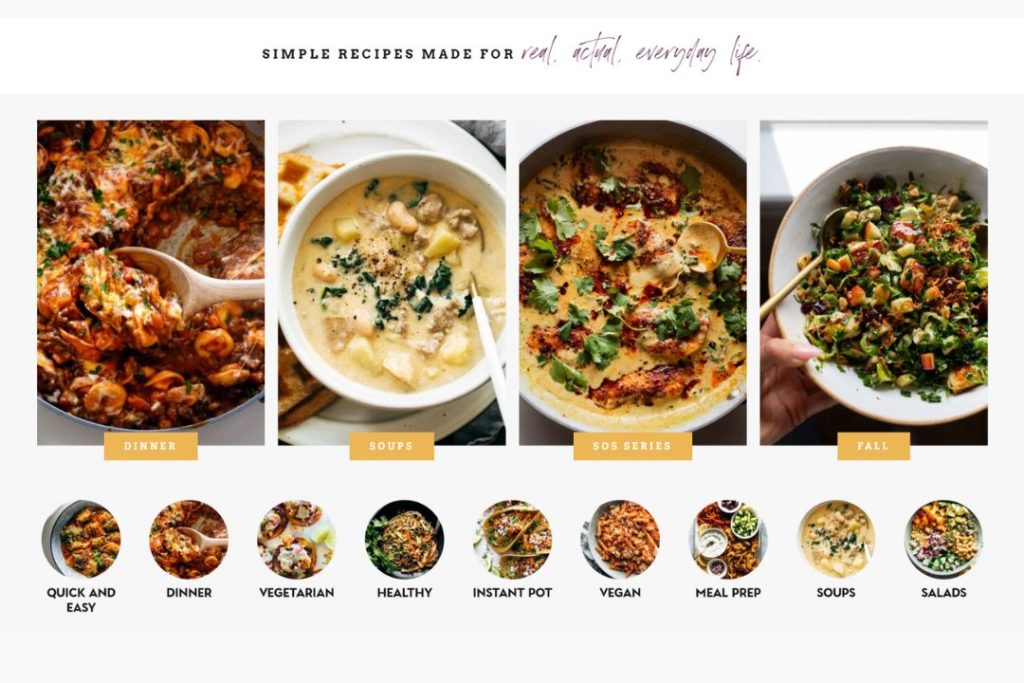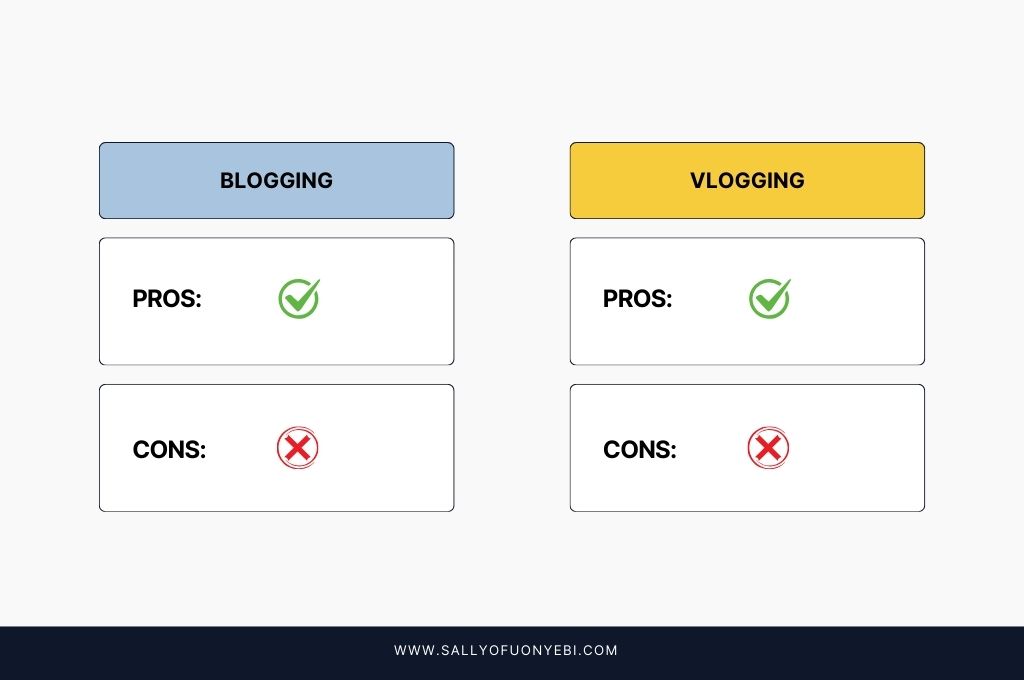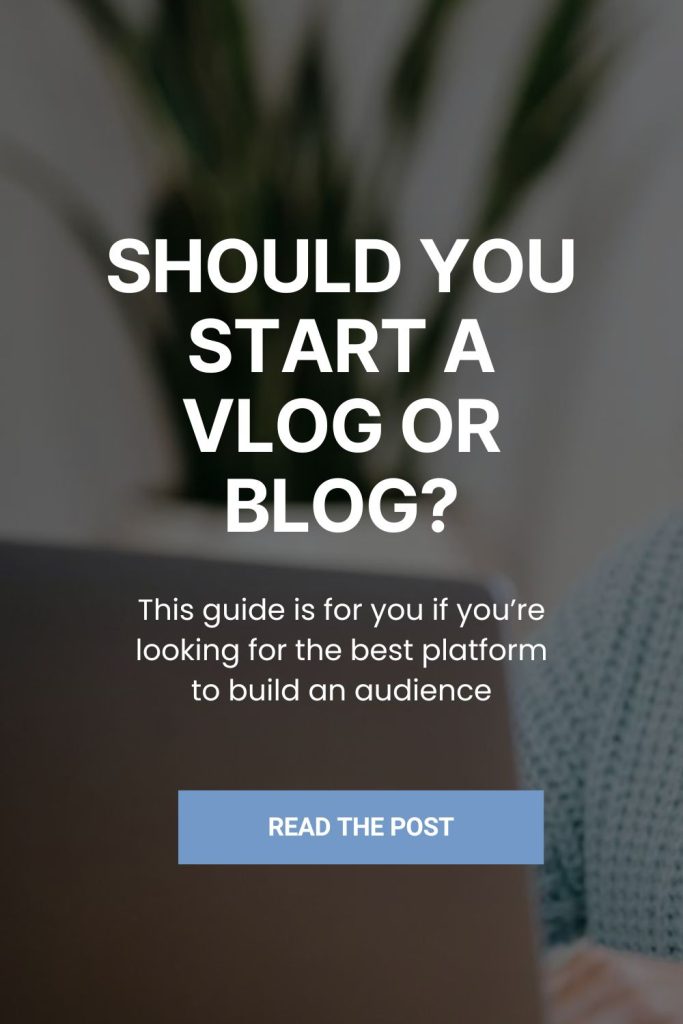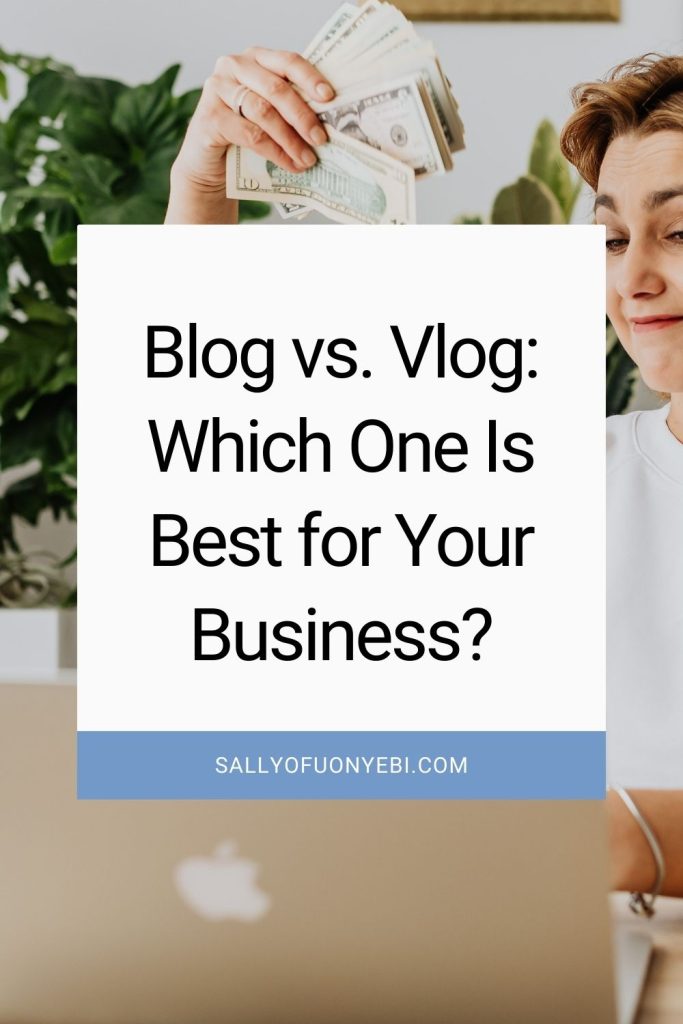As a business owner looking to grow your audience online, you’re faced with a big question:
Should you start a blog or vlog?
In this guide, I’ll break down every aspect of each medium so you have all the information you need to make the best decision and build your online presence in a way that feels good for you.
Table of Contents
Blog vs. vlog: The definition
To kick things off, let me quickly define the terms “blog” and “vlog”:
Blog (web log)
A blog is a platform where you post text-based posts on content management systems like WordPress, Squarespace, and Showit.
These posts are “blog posts” or “entries” and can be on any topic you choose to focus on.
The term “blog” is a shortened version of “weblog,” coined by Jorn Barger in 1997.
Peter Merholz later broke the word into “we blog” in 1999, which led to the term “blog” being used as both a noun and a verb.
Vlog (video blog)
A vlog, short for “video blog,” is essentially the video version of a blog.
Instead of written entries, vloggers (aka, video bloggers) share their thoughts through video content hosted on video-sharing platforms like YouTube and Vimeo.
Like blog posts, these videos can range from casual, diary-style entries to topic-specific content.
The term “vlog” started gaining popularity in the early 2000s with the rise of video hosting platforms. Adam Kontras created one of the earliest known vlogs in January 2000, when he posted a video alongside a blog entry.
Examples of blogs and vlogs
There isn’t a niche that can’t grow either by blogging or vlogging—because people are searching for everything. Money making tips, gardening tips, coaching techniques, Canva tips, and even journaling prompts. Everything, literally.
Successful blog examples
To give you a better idea of what successful blogs look like, let’s explore some popular examples in various niches:
1. Pinch of Yum

Pinch of Yum, by Lindsay Ostrom, is a food blog that shares simple, healthy, and tasty recipes for every day. This food blog receives an average global traffic of 3.4 million every month.
2. Ryan Robinson

Ryan Robinson is a freelance writing consultant who blogs about all things freelancing, blogging, small business, and AI content creation. His website receives an average monthly global traffic of 500,000.
3. Luisa Zhou

Luisa Zhou is a business coach who helps entrepreneurs scale their businesses to six and seven figures. She provides them with the tools and support they need to thrive online. Her blog, where she shares actionable advice, receives about 200k global traffic monthly.
Successful vlog examples
Want to see some successful vlogs, here are some popular examples in various niches:
1. Odetta Kerr-Rockhead

Odetta Kerr-Rockhead shares tips on how to make money online, whether you’re young or old. She has built her community to over 1.27 million subscribers and millions of views.
2. Jade Beason

Jade Beason is a content creator sharing tips on how others can become creators and earn through social media. She has built her community to over 225,000 subscribers.
3. Amanda Frances

Amanda Frances is a money coach, online course creator, and multimillionaire. She shares tips to help more women become financially abundant.
The key differences between a blog and a vlog
While blogs and vlogs share the common goal of sharing content with a dedicated audience, they differ in several key aspects.
| Factors | Blog | Vlog |
| Type of content | Text-based posts | Video-based content |
| Content Creation Process | Involves researching, writing, editing, and sourcing or creating graphics. | Requires scripting, filming, video editing, captioning, and graphic creation. |
| Discoverability | found directly or through search results pages | found on directly, on YouTube, and on search result pages. |
| Equipment needs | Minimal—primarily a computer with internet access. | More extensive—camera (can be a smartphone), microphone, laptop, and lighting. |
| Content consumption | Can be quickly skimmed or read in-depth. Easier to consume in parts. | Requires more dedicated attention. |
| Technical skills | Writing, basic photo editing, and understanding of content management systems (e.g., WordPress). | Video filming and editing skills, possibly audio editing, and understanding of video platforms. |
| Time investment | Writing time varies depending on your typing speed, but editing is generally quicker. Can be done in short bursts. | Often requires more continuous blocks of time for filming and usually longer for editing. |
| Platform control | Fully controlled on your own website. | Often reliant on third-party platforms (e.g., YouTube). |
| Content refresh | Easily updated or edited after publication. | More challenging to update once published. Usually requires re-filming or complex editing. |
Understanding these differences is vital to choosing the medium that aligns best with your goals, skills, and resources.
Vlogging vs. blogging: pros & cons
Here are the benefits and drawbacks of each of these content mediums.
Pros of vlogging
Vlogging has gained immense popularity in recent years, and for good reason. Here are some of the major advantages of starting a vlog:
- You can leverage YouTube, which is the second largest search engine after Google.
- Vlogging is perfect for demonstrating products, techniques, or processes.
- Many people find video formats more engaging and easier to consume.
- You can build trust and form a personal connection with your target audience.
- You can showcase your personality without trying too hard.
- It’s easy to convey complex ideas through visual aids and demonstrations.
- Visual content often appears in Google search results, potentially increasing visibility.
- You get access to multiple revenue streams, like ad revenue, sponsorships, and merchandise.
- You can cover a topic explicitly and release lengthy videos.
- Videos can drive traffic to your website or other platforms.
Cons of vlogging
While vlogging offers many benefits, it’s important to consider the potential drawbacks:
- It is time-consuming to film and edit videos, especially complex ones.
- Vlogging equipment costs more because quality cameras, microphones, and lighting can be expensive. Plus, you may need to upgrade equipment as your channel grows.
- Mistakes are more noticeable than in writing, and this can cause pressure to release “perfect” videos and appear energetic to avoid criticism.
- It’s harder to edit or update content after publication.
- Because you rely on a third-party app, you risk losing content or audience if a platform shuts down or changes dramatically.
- You need to be careful with music, clips, or images used in videos to avoid the risk of copyright strikes or content removal.
- Video files take up significant storage space, so you need to create a robust solution to prevent loss of footage.

Pros of blogging
Blogging has been a popular form of content creation for decades, and it continues to offer numerous advantages:
- There’s a lower barrier to entry because you just need a computer and internet connection.
- Search engines can easily index text-based content.
- Content is highly accessible—to readers with hearing impairments and those who want to translate into other languages.
- Readers can take their time to digest information at their own pace.
- It’s easier to update published content and keep your blog fresh.
- There are diverse monetization options, such as affiliate marketing, sponsored posts, and display advertising.
- It’s easy to link to and collaborate with other bloggers.
- It’s ideal for presenting technical topics. Readers can easily reference and return to specific sections, and you can support your content with charts and illustrations.
- You can run a blog even if you’d like to stay anonymous.
- It requires lower ongoing costs. Once your blog is set up, maintenance costs are generally low.
- There’s more control because you host your content on your own domain.
Cons of blogging
While blogging offers many benefits, it’s important to consider potential disadvantages:
- Creating quality blog posts can be time-consuming.
- Blogging is highly competitive, so to stand out, you need a high level of commitment
- You need to learn about technical stuff such as web hosting, domain management, and CMS platforms.
- It is harder to convey personality and build a personal brand solely through text.
- You need to understand and implement SEO best practices to rank on the SERP.
- It often takes longer to gain traction compared to video content.
Vlog vs. blog: Income potential
Both vlogging and blogging offer various monetization opportunities, but the approaches and potential earnings can differ:
Vlogging income sources:
Ad Revenue:
- YouTube Partner Program (55% of ad revenue goes to the creator)
- Typically requires 1,000 subscribers and 4,000 watch hours in the past 12 months
- Earnings vary widely, from $0.01 to $0.03 per view on average
Sponsorships and Brand Deals:
- It can be very lucrative for popular vloggers
- Rates are often based on subscriber count and engagement
- Micro-influencers (10,000-50,000 subscribers) might earn $200-$1,000 per video
- Macro-influencers (500,000+ subscribers) can earn $10,000+ per sponsored video
Affiliate Marketing:
- You earn commissions by promoting brand products
- Earnings vary by product and company
- It can be particularly effective for product reviews or tutorial videos
Merchandise Sales:
- It’s about creating and selling branded merchandise (t-shirts, mugs, etc.)
- It requires an engaged fan base
Crowdfunding and Patronage:
- Some platforms (such as Patreon) allow fans to support creators directly
- It can provide a steady monthly income
- It offers the opportunity for exclusive content for supporters
Speaking Engagements and Appearances:
- Popular vloggers may be invited to speak at events or appear in other media
- You can charge anywhere from hundreds to tens of thousands of dollars
Blogging income sources:
Display Advertising:
- You earn through networks like Google AdSense, Mediavine, or AdThrive
- Revenue is based on page views and click-through rates
- You can earn $1-$10 per 1,000 page views, depending on niche and audience
Affiliate Marketing:
- It’s similar to vlogging, but often more effective due to in-depth written reviews
- It can be seamlessly integrated into content
- Commission rates vary widely, from 1% to 50% or more
Sponsored Posts:
- Companies pay for dedicated articles featuring their products or services
- Rates can range from $50 to $10,000+ per post, depending on blog traffic and niche.
Digital Products:
- You can sell Ebooks, online courses, webinars, and printables
- Potential for passive income
Coaching or Consulting:
- You can leverage blog expertise to offer one-on-one or group services
- Rates can range from $50 to $500+ per hour, depending on niche and experience
Membership Subscriptions:
- You offer premium content or community access for a recurring fee
- It can provide stable, predictable income

Income comparison:
- Scalability: Blogging can be more easily scaled without a proportional increase in workload. Successful blogs can continue earning from older content.
- Longevity: Blog posts can generate income for years, while vlog revenue may decrease as videos become outdated.
- Niche Dependence: How much you can earn in both mediums heavily depends on your niche—how competitive or lucrative it is.
- Growth Potential: Videos can go viral, leading to rapid growth for a channel. Although blogs see more steady growth, some posts can become traffic magnets.
Ultimately, the income potential for both vlogging and blogging can be significant, but it requires consistent effort, quality content, and effective marketing strategies. Success in either medium often takes time and persistence.
Choosing the best fit
Here’s a detailed breakdown of what you should consider to make the best choice:
- Your strengths. Do you enjoy writing? If so, blogging might be your best bet. Or are you more comfortable on camera? Then, vlogging could be a good fit.
- Content type. Visual topics like travel, cooking, or fashion often benefit from the visual nature of vlogs, while those requiring detailed explanations and step-by-step guidance might be better suited to blogging.
- Time and resource availability. Vlogging needs a lot of time for filming and editing. So, assess your available time realistically. Also, consider your budget for equipment. Based on your schedule and current resources, choose the medium that supports your consistency.
- Technical skills and learning curve. Are you willing to improve your writing skills or learn video editing? Or do you already possess these skills?
- Privacy Concerns. If you prefer to maintain anonymity, you should blog. It offers more room for privacy.
- Content Longevity. Blog posts often have a longer shelf life and can continue to attract traffic over time. However, if your content is trend-sensitive, video content might be advantageous.
There is no right or wrong choice. Many successful content creators start with one and then use the other to reach a wider audience and achieve their business goals.

How to start a blog or vlog
Whether you choose traditional blogging or vlogging, here are some quick tips on getting started.
Starting a blog
- Choose your niche
- Select a self-hosted blogging platform like WordPress.org
- Get a domain name and hosting
- Design your blog
- Develop a content strategy
- Write high-quality, valuable textual content
- Promote your content
Starting a vlog
- Choose a niche
- Decide your hosting platform—YouTube
- Create your channel
- Map out your content marketing strategy
- Write your scripts
- Record your high-value videos
- Promote your video content.
Blog vs. vlog: FAQs
Q1: Can I blog and vlog?
Absolutely! Many business owners successfully combine both mediums. You can create blog posts that complement your videos, or vice versa, to cater to different audience preferences and maximize your reach.
Q2: Which one makes more money?
Both can be profitable, but the income potential depends on factors like your niche, audience size, and monetization strategies, although vlogging can sometimes offer quicker initial monetization through ad revenue.
Q3: Do I need to be an expert to start a blog or vlog?
While expertise can be beneficial, it’s not always necessary. Many successful bloggers and vloggers start as enthusiasts and learn along the way. What’s most important is providing value to your audience, whether through information, entertainment, or inspiration.
Q4: How often should I post?
Consistency is key for both blogging and vlogging. For blogs, posting at least once a week is often sufficient. For vlogs, many successful vloggers post 1-2 times per week. The most important thing is to maintain a schedule you can consistently meet.
Q5: How long does it take to see results?
Building an audience takes time for both blogs and vlogs. It’s common to see significant growth after 3-6 months of consistent, quality content creation. However, this can vary widely depending on your niche, promotion efforts, and content quality.
Remember, whether you choose to blog or vlog, the key to success is consistently creating valuable content for your audience. Be patient, and keep learning as you grow.
Looking to simplify your blog or vlog content workflow? Grab this free AI Prompts Cheat Sheet.
If you’d like to start your business blog, but don’t enjoy the writing or strategy part of it, let me handle it for you.





